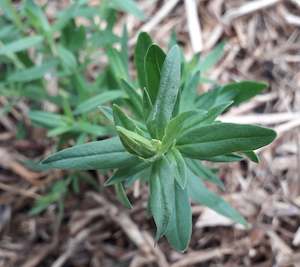Hyssop

Botanical name: us officinalis
Life cycle: Perennial
Height: 60 cm
Position: Full sun
Soil preference: Well drained
Description
a low-growing, shrubby, perennial herb that reaches up to 60 cm in height. It has many woody stems with small, dark green, narrow leaves, and spikes of purple-blue double-lipped flowers in late spring and through summer and autumn. The flowers are highly fragrant. The whole plant has a refreshing aromatic scent.
a decorative plant that will complement any flower garden or can be used as a border plant or low hedge.
Uses
Culinary - In cooking the fresh or dried leaves can be used as a flavouring for soups, stew, sauces, and egg dishes. useful in meals with a high fat content as it aids fat digestion. The sweetly scented flowers can add flavour and colour to green salads or be used in pickles and preserves. The flavour is somewhere between sage and mint and is quite strong.
Medicinal - has many active ingredients and contains terpenes, volatile oils, and flavonoids. It also contains the chemicals thujone and phenol, which have antiseptic properties.
has a long history of use as an expectorant in respiratory conditions. It has a positive effect when used to treat bronchitis and respiratory infections, especially where there is excessive mucus production. appears to encourage the production of a more liquid mucus, and at the same time gently stimulates expectoration. This combined action clears thick and congested phlegm. can irritate the mucous membranes, so it is best given after an infection has peaked, when the herb’s tonic action encourages a general recovery.
potentially useful as it is both calming and tonic. As a sedative, hyssop is a useful remedy against asthma in both children and adults, especially where the condition is exacerbated by mucus congestion. Like many herbs with a strong volatile oil, it soothes the digestive tract and can be an effective remedy against indigestion, wind, bloating and colic.
Caution - essential oil can induce epileptic seizures. It should only be used under professional supervision. Avoid in pregnancy.
Household - The leaves and flowers of hyssop dry well for potpourri.
Companion planting - The flowers are very attractive to bees. Grape vines are said to do better with hyssop growing near them.
Growing conditions
prefers a well-drained sandy-loam and an open sunny position, however, the plant will tolerate shade for part of the day. can often tolerate dry periods while waiting for rainfall, so there is no need to over water. Can be trimmed into a hedge or used as ground cover plant.
9cm pot.
Organically grown plant in a biodegradable coir pot.
